 Image search results - "mori" Image search results - "mori" |

Road marker. Established in 1642, Moriyama-juku was the sixty-seventh of the sixty-nine stations or shukuba post towns on the Nakasendo Road. It is the eighth Nakasendo station in Shiga (following Musa-juku in Omi-Hachiman).
|
|
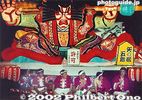
Nebuta are giant, wire-frame, paper lanterns shaped in various legendary and macho characters.The Aomori Nebuta Matsuri is held in Aomori City in Aomori Prefecture during Aug. 2-7. Nebuta are giant, wire-frame, paper lanterns shaped in various legendary and macho characters such as samurai warriors, demons, and gods. They are fantastic works of art dramatically illuminated from the inside. The floats are paraded along the main streets of the city near Aomori Station every night of the festival.
From August 2 to 6, the Nebuta parade is held from 7 p.m. to 9 p.m. On the 2nd and 3rd, the parade is geared for the many children who participate by pulling the floats. About 15 large Nebuta floats and some small Nebuta floats for the children are paraded.
The festival's peak period is from the 4th to the 6th when over 20 large Nebuta floats make their rounds. Be sure to see the festival on one of these three nights.
On the 7th, the last day, the parade is in the afternoon from 1 p.m. to 2:30 p.m. Later in the evening, the Nebuta floats are put on boats to be highlighted by a fireworks display.
The festival is designated by the government as an Important Intangible Folk Culture Asset and not to be missed if you have the chance. It's well worth the trip up north.
|
|

Moving the Neputa floats into position.Held during Aug. 1-7, the Hirosaki Neputa Matsuri is without the rowdiness of the Aomori Nebuta Matsuri. Instead of the haneto, there are many children pulling the floats with ropes. The main floats are fan-shaped and more two-dimensional and lantern-like. As with the Nebuta floats, the Neputa floats are handpainted and illuminated from the inside. There are two parade routes which are followed alternately on different nights. On the 7th, there is only a daytime parade from 10:00 a.m. If it rains on any day, the parade may be canceled.
|
|

Road marker. Go right for the Nakasendo Road. MAP
|
|
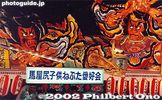
The Nebuta floats are judged in a contest and various awards are given.The Nebuta floats are beautiful objects of light. They are swung left and right and all around. The crowd applaud whenever the Nebuta faces them directly. The sculpture's lights inside are powered by a noisy generator on wheels under the float. The parade progresses quickly and the splendid Nebuta figures pass by one after another. You have to be there in person to feel the power and presence of the giant Nebuta. They represent the very soul and spirit of men. It's enough to give you goose bumps.
The Nebuta floats are judged in a contest and various awards are given. The best ones are preserved at the Nebuta-no-Sato (Nebuta Village) after the festival.
|
|
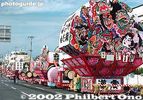
There are three types of floats: the large fan-shaped Neputa, Nebuta-type figures, and the children's small Neputa.I got to Hirosaki early enough before the parade to see the floats lined up at the starting point. Hirosaki is a 30-min. train ride from Aomori, and best known for Hirosaki Castle during cherry blossom season.
|
|

Rear of road marker
|
|
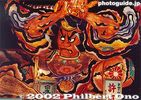
According to one story, the Nebuta has its roots in the 8th century.According to one story, the Nebuta has its roots in the 8th century when there was a rebellion in Ezo (Hokkaido). Ordered by Emperor Kanmu to quell the rebellion, generalissmo Sakanoue no Tamuramaro went to Ezo. However, he failed to capture the elusive chief of Ezo who went into hiding in the mountains.
Sakanoue then set up a trap with large votive lanterns which were lit and accompanied by taiko drums and flutes. This lured the curious Ezo chief out of hiding and led to his capture. The large lanterns were the forerunner of the Nebuta.
|
|

Lunch break
|
|

Marker for the Kabuto-ya inn
|
|
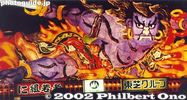
The first Nebuta was a large paper lantern made in 1593.According to historical records, the first Nebuta was a large paper lantern made in 1593 by Lord Tamenobu of Tsugaru (now part of Aomori) for the Bon festival in Kyoto. The Nebuta Festival itself started in the late 17th century.
|
|
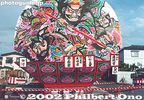
Fan-shaped Neputa float.The painted picture on the front of the Neputa depicts mostly warriors and on the back are beautiful courtesans.
|
|

Old Nakasendo Road and Dobashi Bridge. Supposedly, this is the bridge from where Hiroshige drew his print of Moriyama-juku.
|
|

Preparation for building a Nebuta sculpture starts right after the preceding Nebuta Festival.Preparation for building a Nebuta sculpture starts right after the preceding Nebuta Festival. During fall and winter, Nebuta artists conceive the ideas for the next year's Nebuta floats. The Nebuta figures depict some scene from kabuki or Japanese/Chinese history or legend. Once a theme is chosen, a sketch or design is made and presented to the sponsor (usually a company). Upon approval, actual construction begins.
During February and March, the smaller parts of the Nebuta figure, such as the hands and fingers, are constructed at home with steel wiring.
In May, a tent village is put up. In each tent, full-scale construction of the Nebuta is executed until the end of June. Steel wiring and slender pieces of wood are used to build the frame and props.
After the skeleton of lumber and wire is completed, about 400 light bulbs and fluorescent lights are installed inside. The lights are strategically placed so that the shadow of the lumber pieces is not cast outward.
Then comes the tedious task of pasting washi paper on the wire frame. This is done by highly-skilled housewives who have been doing it for 10 to 20 years. About ten of them work on one Nebuta, taking about 10 days. Since they have to work dextrously in all sorts of contorted positions, it is not a popular job and fewer women are willing to do it.
The paper is cut to fit the exact segment (usually rectangular) on the wire frame. A toothbrush is used to apply glue on the wiring and the paper is pasted and cut. Extra care is taken when the figure's face is papered. About 2,500 sheets of 531 x 393 mm paper are consumed in the process.
|
|

The floats were jerked left and right and spun around.At 7:00 p.m., the taiko drum-beating started and the floats left the starting point one by one. The beat of the taiko drums was the same as that in the Nebuta Matsuri. A few men stood on the top of the large Neputa and collapsed the hinged, top portion to clear overhead power lines. The floats were jerked left and right and spun around.
|
|

Dobashi Bridge
|
|
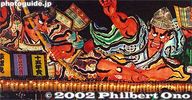
There are fewer than 30 Nebuta artists in the world.The giant white figure is brought to life by a Nebuta artist who paints it all by himself. First, the figure's basic outlines are painted with black sumi ink. Liquid paraffin is then applied to prevent the ink from running. Then colored dyes are painted or sprayed. When it comes to the face, very special care is taken. If he makes a mistake on the face, the paper is torn away and new sheets are pasted on. The very last thing painted on the Nebuta are the eyeballs. They give the sculpture its soul.
The completed Nebuta is lifted from the ground by 50 people onto a 1.5-meter-high wheeled platform. An illumination test symbolizes the Nebuta's completion. To ensure easy movement on the street, the Nebuta float is restricted to a width of 9 meters and a height of 5 meters. The float also bears the name of the sponsoring company or organization. It costs 10 to 20 million yen to build and operate a large Nebuta float. Corporate sponsors think it's money well spent since the Nebuta makes a great advertising vehicle and enhances the corporate image.
Top Nebuta artists are given over 3 million yen to cover labor and materials costs. By the time all the bills are paid, the artist has less than one-third the amount as compensation. Obviously, Nebuta artists are grossly underpaid for their highly-appreciated work. It really is a labor of love, and not for the money.
There are fewer than 30 Nebuta artists in the world, and only three of them work as full-time Nebuta artists. Since there is no money in it, would-be Nebuta artists and apprentices are few. To make it worse, there are no governmental measures to help resolve the problem.
|
|

Nebuta-type float with a paper sculpture of a figure.
|
|

Tomon-in temple built by Buddhist Priest Saicho (Dengyo Daishi) to protect his Enryakuji temple on Mt. Hiei from demons from the east. 東門院
|
|

The Nebuta festival is a great visual spectacle as well as a sound delight.The Nebuta festival is a great visual spectacle as well as a sound delight. The resounding beat of the taiko drums and the shrill of the flutes give the festival its soul. These are placed at regular intervals throughout the parade. The taiko beat is simple and repetitive, yet powerful and infectious.
|
|
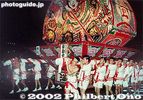
Neputa float. All the floats are on wheels so these people are not actually carrying the floats.
|
|

Kaeru frog to wish you a safe return. 東門院
|
|

Distinctly-costumed dancers called haneto.Each Nebuta float is accompanied by thousands of distinctly-costumed dancers called haneto. The huge Nebuta overlook a sea of haneto out in front with their colorful flowered straw hats bobbing up and down. They jerk and jingle and hop all over the road while shouting "Rasse, Rasse, Rassera!" They twist and shout amid reverberating taiko drums and flutes.
Sometimes they form a small circle and dance in unison. Their costumes have little bells which often fall off. Little kids run and pick up the fallen bells on the road. It is a frenzied celebration. If you want to join in the fun, you have to rent or buy a haneto costume (for around ¥10,000).
|
|
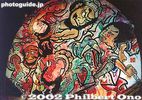
Closeup of a Neputa float.Theories concerning the origin of the Neputa are identical to those of the Nebuta. However, in the 1880's, the Neputa gradually changed from human figures into a fan shape. The floats have come a long way since then. Candles have been replaced by generator-powered lights and the washi paper has been replaced by washi paper blended with nylon. The festival is designated as an Important Intangible Folk Culture Asset.
|
|

樹下神社
|
|

The parade route is quite long, and it's crowded along the parade route near Aomori Station.The parade route is quite long, and it's crowded along the parade route near Aomori Station. If you want plenty of elbow room while viewing, go toward the end of the parade route where the crowd is sparse.
In recent years, the Nebuta Festival has seen disturbances caused by gate-crashing, young hoodlums. A large police force is put in place to prevent trouble.
|
|

People pull the float along.
|
|

Entrance to Iimoriyama Hill, site of the Byakkotai "White Tiger" Battalion gravesite. In 1868, a unit of teenage warriors called Byakkotai (White Tiger Battalion) fought against the Emperor-backed Imperial forces encroaching their domain of Aizu
|
|

Sumiyoshi Shrine is on the west side of JR Moriyama Station. This side has an area called "Fuke" written with the same kanji for "uwaki" (cheating on your partner).I wonder what married couples think of living in this area...
|
|
|

Former Hatano residence and birth home of Yoshida Togo 旧旗野邸 (吉田東伍生家)
|
|
|

And sometimes they have to stop it.
|
|

The Byakkotai were outnumbered and forced to retreat. Twenty of them escaped to Iimoriyama Hill where they saw what looked liked a burning Tsurugajo Castle. Photo: Pay a small fee to take the escalator up the hill. Or climb up the steps for free.
|
|

Sumiyoshi Shrine torii. Notice the torches inside the shrine. 住吉神社 MAPEvery Jan., both this shrine and Katsube Shrine light giant torches for the festival's climax. Unfortunately, you cannot see the festival at both shrines since they are held around the same time. Sumiyoshi Shrine's fire festival is smaller with fewer (six) torches which represent the head of the slain dragon.
|
|
|

Rear view of birth home of Yoshida Togo who was a famous geographer of Japan who compiled an encylopedia of Japanese place names. His son was Yoshida Chiaki who composed the melody of the song "Biwako Shuko no Uta" (Lake Biwa Rowing Song).
|
|
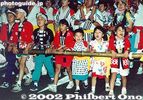
Children's night at Aomori Nebuta MatsuriOn the 2nd and 3rd, the parade is mainly for children who participate by pulling the floats. About 15 large Nebuta floats and some small Nebuta floats for the children are paraded.
|
|

Float pullers at Hirosaki Neputa Matsuri
|
|

In despair, the boys decided to kill themselves rather than die in the hands of the enemy. Photo: Escalator to go up Iimoriyama Hill.
|
|

Sumiyoshi Shrine and the six giant torches.
|
|

Stone for safe childbirth
|
|

A room in the birth home of Yoshida Togo
|
|
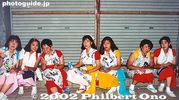
Some female haneto taking a break after the festival.
|
|
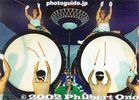
The beat was the same as at the Nebuta Festival.There were also many giant taiko drums with female taiko drummers.
|
|

Escalator to go up Iimoriyama Hill. Their tombstones are on this hill near where they killed themselves. Their story has become legend.
|
|

Sumiyoshi Shrine and the six giant torches.
|
|

Tenmangu Shrine
|
|

Garden of the birth home of Yoshida Togo
|
|
|

The long, slender drum sticks make a very penetrating, slapping sound.The drum sticks are long, slender, and slightly elastic. They make a very penetrating, slapping sound. It's a real treat to watch these vivacious women beating these huge drums in unison.
|
|

Byakkotai Gravesite. It is on a flat area which also has several other Byakkotai monuments including those from other countries.
|
|

Side view of torches.
|
|

Tenmangu Shrine
|
|

Entrance to the Yoshida Togo Memorial Museum which exhibits various documents and personal effects of Yoshida Togo. Museum admission 300 yen. Closed Mon.
|
|

Nebuta Danchi village where the floats are stored during the day.During the day, the Nebuta floats are housed in a tent village (Nebuta Danchi) open to the public. Each Nebuta has its own giant, green tent. These are the same tents used when the Nebuta were constructed.
|
|

Drumming at sunset.The Neputa Festival is not as big as the Nebuta Festival and has smaller floats, but it has its own, unique attractions. Hirosaki is a highly recommended side trip from Aomori.
|
|

Festival during the day.
|
|

Approach to the Byakkotai gravesite.
|
|

Head of torch. Different shape from Katsube Shrine's torches.
|
|

Inside Yoshida Togo Memorial Museum. The 2nd floor also has a display panel about his son Yoshida Chiaki who composed the song "Hitsuji-gusa" whose melody was used in the song "Biwako Shuko no Uta" (Lake Biwa Rowing Song).
|
|

Many children come and sit in front of the Nebuta to sketch it.
|
|
|
|

Torch stem
|
|
|

Nice during the day, but more dramatic at night.
|
|

Graves of the 19 teenage Byakkotai warriors who killed themselves with their own swords.
|
|

Straw-covered torches.
|
|

This young girl was quite a talented artist who drew the attention of the other kids.
|
|
|

Byakkotai Graves
|
|

Torches are bunched together.
|
|

Perhaps she might be able to help paint (or build) the real thing someday.
|
|
|

Byakkotai Graves
|
|
|
|

Taiko drummer
|
|

Byakkotai gravestones. Each one shows the name, age, and method of death called "jijin" (died with one's own sword 自刃).
|
|
|
|
|
|

This has become a national shrine, almost as important as Sengakuji where the 47 masterless samurai are buried.
|
|
|
|
|
|
|

Back of the torch heads.
|
|
|
|
|

On the right side are more gravestones. These are 31 Byakkotai members who died in battle. 戦死
|
|
|

Tombs of those Byakkotai who died in action.
|
|
|

Tombs of those Byakkotai who died in action.
|
|

Sumiyoshi Shrine
|
|

Their names, age, and "senshi" 戦死 (died in battle) are engraved on the stones.
|
|

Men in loincloths beat the wall in a building, then came out with small torches.
|
|
|

First man lights the giant torches. This was around 7:45 pm.
|
|

Monument for teenage samurai who died in battle.
|
|

More men light the torches. The straw ignited almosty immediateely and no kerosene was used.
|
|

Names of Byakkotai members, all 14 to 17 years old.
|
|

The torches burn within seconds.
|
|

On the left of the gravestones, there is a monument for a poem composed by Lord Matsudaira Katamori, the last Aizu lord and whom the Byakkotai died for. 幾人の 涙は石にそそぐとも その名は世々に 朽じとぞ思う幾人の 涙は石にそそぐとも その名は世々に 朽じとぞ思う
Ikutari no namida wa ishi ni sosogu tomo sono na wa yoyo ni kuji to zo omou
"No matter how many people pour their tears on these stones, these names will never fade from the world."
|
|

Sumiyoshi Shrine Fire Festival
|
|

A short walk away is the grave of Iinuma Sadakichi, the only Byakkotai survivor who had slit himself, but was rescued by a villager passing by when everyone else had killed themselves.
|
|

The fire at its peak was very hot to the skin. Sumiyoshi Shrine Fire Festival, Moriyama, Shiga in late Jan.
|
|

Grave of Iinuma Sadakichi, the only Byakkotai warrior who survived and told the story of this valiant teenage group.
|
|
|

Grave of Iinuma Sadakichi (Sadao) (1854-1931). His grave was built here in 1957 for the 90th anniversary of the Byakkotai's demise. 飯沼貞吉
|
|

The torches burnt out within a few minutes.
|
|

About Iinuma Sadakichi (later changed his first name to Sadao)
|
|
|

Slope where they committed seppuku (hara-kiri). 自刃の地
|
|
|

Site where they committed seppuku (hara-kiri). 自刃の地
|
|

Before the torches burnt out completely, the men hauled away each torch one by one.
|
|
|

Sumiyoshi Shrine Fire Festival, Moriyama, Shiga Pref. on the second Sat. of January.
|
|
|
|
|
|

Taming the firre.
|
|
|
|

Great way to warm up.
|
|
|
|
|
|

The festival ended quickly. A lot faster than the Katsube Shrine's Fire Festival held at the same time.
|
|

A recent addition is this statue of a teenage samurai looking at Wakamatsu Castle.
|
|

Fire hydrant and hose just in case.
|
|

Statue of a teenage samurai looking at Wakamatsu Castle.
|
|

Fire truck and burnt torch.
|
|
|

Statue faces Tsuruga-jo Castle which can be seen in the distance.
|
|

Arrow points to Tsuruga-jo Castle.
|
|
|

Byakko Kannon statue
|
|
|
|
|

Monument from Rome, Italy, given in 1928 by Mussolini. The column is from the ruins of a palace in Pompeii.
|
|

Monument message in Italian. After WWII, the US Occupation authorities wanted this monument removed. But all they did was remove the engraved message (later restored).
|
|

About the monument from Rome.
|
|

Monument from a German, Hasso von Etzdorf (1900 - 1989).
|
|

Another monument
|
|

Opened in 1956, the Byakkotai Memorial Museum has numerous artifacts related to the Byakkotai as well as the Shinsengumi. Photography inside is not allowed. Admission 400 yen.
|
|

Byakkotai statue outside the Byakkotai Memorial Museum
|
|
|
|

Uga Shrine 宇賀神社
|
|

Byakkotai enshrined in Uga Shrine
|
|

Painting depicting Byakkotai suicide on Iimoriyama Hill
|
|

Sazaedo, a unique wooden, hexagonal structure which you will see when coming down from Iimoriyama.
|
|

Sazaedo
|
|

Sazaedo
|
|

Sazaedo
|
|
|
|

Byakkotai souvenirs
|
|

Hirosaki Castle tower
|
|

Castle towerThe castle tower is so small that it looks more like a turret.
|
|
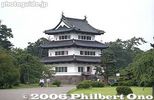
Honmaru
|
|
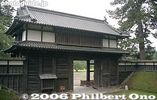
Gate追手門
|
|

Amenomori is Takatsuki's showcase and flagship area. It's a quiet, rural part of town with waterwheels, roadside streams and flowers. Charming and picturesque.
|
|

This waterwheel has become one of the symbols of this area. It's in front of the Amenomori Hoshu-an museum.
|
|

Road in front of Amenomori Hoshu-an museum dedicated to Amenomori Hoshu (1668-1755), a Confucian scholar and leading diplomat to Korea during the Edo Period.
|
|

Front gate to Amenomori Hoshu-an museum built in 1984. Known as the East Asia Exchange House Amenomori Hoshu-an Museum. 東アジア交流ハウス雨森芳洲庵 MAP
|
|

Large zelkova (keyaki) tree at the museum. Takatsuki has numerous old and distinguished trees.
|
|

Amenomori Hoshu-an museum. Built on the land where Amenomori Hoshu's house once stood. Born in Amenomori, Amenomori Hoshu (1668-1755) was a Confucian scholar and leading diplomat to Korea during the Edo Period.
|
|

Entry to the Amenomori Hoshu-an. It exhibits things, books, documents, etc., related to Amenomori Hoshu. Admission 250 yen. Hours: 9 am - 4 pm, closed Mon. Phone: 0749-85-5095
|
|

This is the museum room with various exhibits related to Amenomori Hoshu and Japan-Korean relations during the Edo Period. Hoshu was based in Tsushima in Nagasaki, an island close to Korea.
|
|

Route of the Korea's royal embassy procession to Edo. The Korean kingdom sent an official mission to Edo when there was a significant occasion, such as the installation of a new shogun. They traveled along this route which also passed through Shiga.
|
|

At age 18, Hoshu went to Edo and studied Confucianism under Confucian scholar Kinoshita Jun'an. He was later employed by the Tsushima clan and was put in charge of Korean relations at age 22.
|
|

Statue of Hoshu. At age 25, Hoshu learned Chinese. At age 36, he lived and studied Korean in Pusan for 3 years during 1702-1705.
|
|

Statue of Amenomori Hoshu. He is regarded as a pioneer in Korean-Japanese relations and an internationally-minded person ahead of his time.
|
|

Hoshu rightly believed that language represented the culture, and learning the language was thus essential to understand the country.In 2017, Amenomori Hoshu's documents related to Japan-Korea relations during the Edo Period will be inscribed as a UNESCO Memory of the World.
|
|

Assembly hall. The museum sometimes holds events. Once a year, they conduct a homestay program for students from South Korea.
|
|

Faces of Hoshu on the wall.
|
|

Tea ceremony room.
|
|

Japanese garden at Amenomori Hoshu-an museum.
|
|
|

Amenomori Hoshu monument (not grave). Hoshu is buried in Tsushima, Nagasaki.
|
|
|
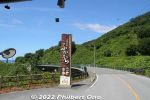
From neighboring Akita Prefecture, entering the town of Fukaura-cho, home of the Shirakami-Sanchi Mountains designated as a UNESCO World Heritage Site.
|
|

Fukaura is in southwestern Aomori Prefecture facing the Sea of Japan. Nice coastal scenery on Route 101.
|
|
|
|
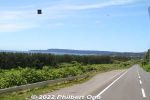
On Route 101 to see the Juniko Lakes (Twelve Lakes) amid the Shirakami-Sanchi Mountains (白神山地).
|
|
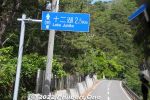
Turn right here for the Juniko Lakes.
|
|
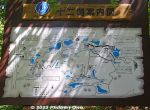
Although "Juniko" means "Twelve Lakes," there are actually over 30 lakes/ponds in the area. They were created when Mt. Kuzureyama collapsed in 1704 due to an earthquake and dammed nearby rivers which formed the ponds/lakes.
|
|
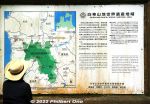
About the Shirakami Sanchi World Heritage Site. Famous for primeval beech forests left untouched by man.
|
|
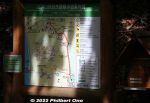
Walking trails along the Juniko Lakes. They are actually ponds (ike). Twelve of the ponds can be seen from the summit of Mt. Okuzure. Perhaps that's why it was named so.
|
|
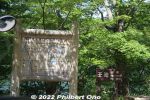
Ou-Ike Pond sign.
|
|

Ou-Ike Pond as seen from our tour bus. 王池
|
|
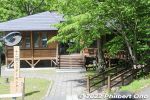
Passed by the Juniko Visitor Center (十二湖ビジターセンター) which has exhibits of the area's flora and fauna. We didn't stop here though.
|
|
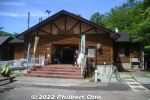
Mori-no-Bussan Kyororo (森の物産館キョロロ) is where we got off the tour bus. This is a local gift shop selling local produce and snacks. Restrooms and rest house too. We walked to the ponds from here.
|
|
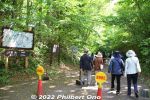
From Kyororo, a 500-meter walk to Ao-Ike Blue Pond.
|
|
|
|
|
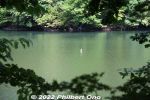
Along the way, we passed by the large Ketoba-no-Ike Pond (鶏頭場の池), one of the Twelve Juniko Lakes.
|
|
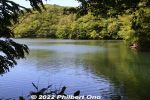
Ketoba-no-Ike Pond (鶏頭場の池) was green. It's one of the largest Juniko Lakes with a surface area of 41,150 sq. meters.
|
|
|

Birds in the forest.
|
|
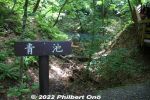
Way to Aoike Blue Pond.
|
|
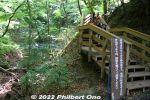
There's a narrow lookout deck along the Ao-Ike pond.
|
|
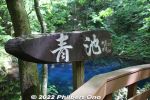
Sign says "Ao Ike" (青池) or Blue Pond, one of the 12 Juniko Lakes.
|
|
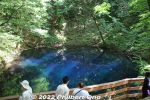
Ao Ike (青池) Blue Pond is perhaps the most famous of the twelve Juniko Lakes. Easily accessible.
|
|
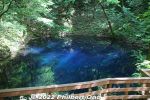
Ao Ike (青池) Blue Pond, one of the 12 Juniko Lakes
|
|
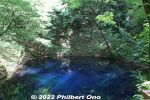
Ao Ike is certainly a beautiful blue.
|
|
|
|
|
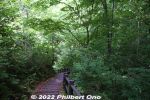
After seeing Ao-Ike blue pond, you can either backtrack and go back to Kyororo Gift Shop or go further and walk through the Japanese beech forest (highly recommended).
|
|
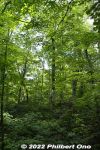
Experience forest bathing in this lush beech forest. Lots of ferns too.
|
|
|
|
|
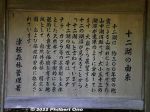
How Juniko Lakes were formed and named.
|
|
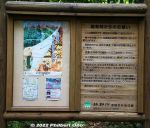
Forest rules: Do not stray away from the trail. Take your trash home, etc.
|
|

Walking trails and roads around Juniko Lakes.
|
|
|
|
|
|
|
|
|
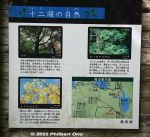
The flora around Juniko Lakes.
|
|
|
|
|
|
|
|
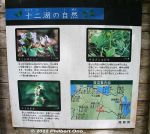
Flowers at Juniko Lakes.
|
|
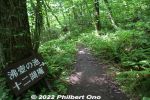
Way to Wakitsubo-no-Ike Pond 沸壺の池(沸壷の池), another blue pond.
|
|
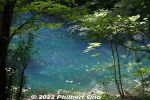
Wakitsubo-no-Ike Pond 沸壺の池(沸壷の池)is another blue pond along the beech forest trail.
|
|
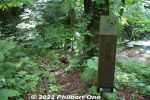
The Music of Water...
|
|
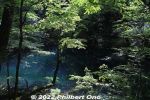
Wakitsubo-no-Ike Pond 沸壺の池(沸壷の池).
|
|
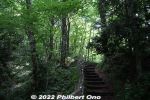
The beech forest trail eventually goes to the main road.
|
|
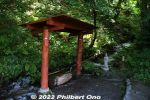
Wakitsubo-no-Ike Pond's Kiyomizu (pure water). 沸壺池の清水
|
|
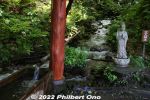
Wakitsubo-no-Ike Pond's Kiyomizu (pure water). 沸壺池の清水
|
|
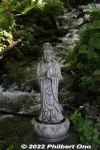
Kannon statue at Wakitsubo-no-Ike Pond's Kiyomizu (pure water). 沸壺池の清水
|
|
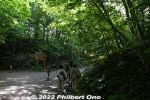
Turn right here to follow the road back to Kyororo. It's an uphill road.
|
|
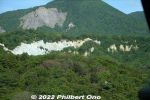
From the road going to/from Juniko Lakes, part of Nihon Canyon with white cliffs can be seen. It was formed by erosion and collapsed mountainsides. 日本キャニオン
|
|

Daughter Sagawa from Moriyama.
|
|
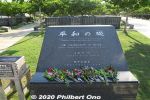
Cornerstone of Peace (平和の礎) in Mabuni, a large oceanfront memorial park full of these stone slabs inscribed with over 240,000 names of people who died in the battle.
|
|
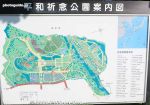
Map of Cornerstone of Peace witin the Okinawa Peace Prayer Park.
|
|
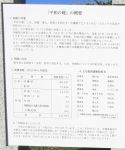
About the Cornerstone of Peace. http://www.peace-museum.pref.okinawa.jp/
|
|
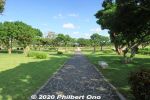
Walking to the Cornerstone of Peace.
|
|
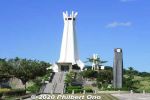
Peace Prayer Memorial Hall in the Okinawa Prefectural Peace Park.
|
|
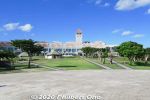
Okinawa Prefectural Peace Memorial Museum (沖縄県平和祈念資料館)
|
|
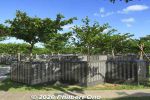
Stone slabs inscribed with over 240,000 names of people who died in the battle. Civilians and military, Japanese and foreign.
|
|
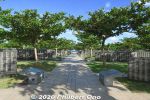
Japanese victims are inscribed by prefecture. Foreign nationals are inscribed by country.
|
|
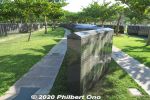
Stone slabs are like folding screens in a slight zig-zag pattern.
|
|
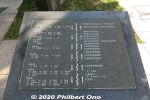
Map of where people's names are inscribed. Okinawans are inscribed according to their hometowns. Nearby are also war memorials for each prefecture.
|
|
|
|
|
| 1174 files on 5 page(s) |
1 |
 |
 |
|